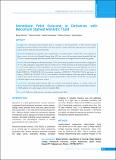Please use this identifier to cite or link to this item:
https://hdl.handle.net/20.500.14356/1180| Title: | Immediate Fetal Outcome in Deliveries with Meconium Stained Amniotic Fluid |
| Authors: | Ghimire, Bijaya Pathak, Pratima Gachhadar, Rashmi Ghimire, Pratima Baidya, Sujita |
| Citation: | GhimireB., PathakP., GachhadarR., GhimireP., & BaidyaS. (2022). Immediate Fetal Outcome in Deliveries with Meconium Stained Amniotic Fluid. Journal of Nepal Health Research Council, 19(04), 681-687. https://doi.org/10.33314/jnhrc.v19i04.3842 |
| Issue Date: | 2021 |
| Publisher: | Nepal Health Research Council |
| Article Type: | Original Article |
| Keywords: | Deliveries fetal outcome meconium-stained amniotic fluid |
| Series/Report no.: | Oct-December, 2021;3842 |
| Abstract: | Abstract Background: Meconium-stained amniotic fluid is considered as the bad predictor of fetal outcome having significant perinatal morbidity and mortality. This study aimed to compare immediate fetal outcomes in meconium-stained amniotic fluid and clear amniotic fluid. Methods: Hospital-based comparative observational study was conducted from a total of 204 women admitted in labour room at a tertiary level hospital. Among them, 102 were cases with meconium-stained amniotic fluid, and 102 were comparison groups with clear amniotic fluid. Fetal outcome was compared between these two groups. Results: The study findings revealed that majority (74.5%) in the study group had cesarean section as compared to 14.7% in the comparative group. More than one-fourth (26.5%) of the newborns in the study group had moderate to severe birth asphyxia, needed resuscitation (25.5%) and neonatal intensive care unit admission (25.5%) as compared to 3.9% from the comparative group. Maternal age (COR=0.34, 95%CI=0.15-0.81), color of amniotic fluid (COR=0.11; 95%CI=0.04-0.33), meconium consistency (COR=0.27; 95%CI=0.17-0.43), and mode of delivery (COR=0.36; 95%CI=0.17-0.79) were associated with birth asphyxia in bivariate analysis. Maternal age (AOR=2.66; 95%CI=1.04-6.81) and color of amniotic fluid (AOR=11.50; 95%CI=2.97-44.56) were associated with birth asphyxia in the multivariate analysis. Conclusions: Meconium-stained amniotic fluid was associated with increased frequency of cesarean section and adverse fetal outcome with birth asphyxia being the major complications compared with clear amniotic fluid. Predictors of birth asphyxia were maternal age and color of amniotic fluid. Keywords: Deliveries; fetal outcome; meconium-stained amniotic fluid |
| Description: | Original Article |
| URI: | http://103.69.126.140:8080/handle/20.500.14356/1180 |
| ISSN: | Print ISSN: 1727-5482; Online ISSN: 1999-6217 |
| Appears in Collections: | Vol. 19 No. 04 (2021): Vol 19 No 4 Issue 53 Oct-Dec 2021 |
Files in This Item:
| File | Description | Size | Format | |
|---|---|---|---|---|
| 3842-Manuscript-26770-1-10-20220313.pdf | Fulltext Download | 269.44 kB | Adobe PDF |  View/Open |
Items in DSpace are protected by copyright, with all rights reserved, unless otherwise indicated.
